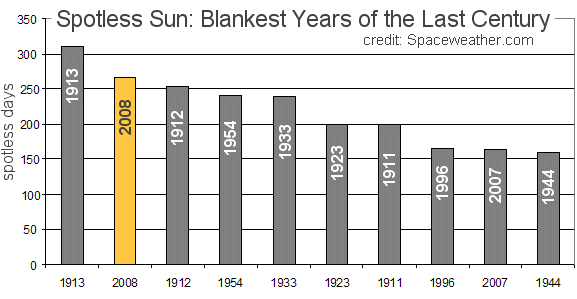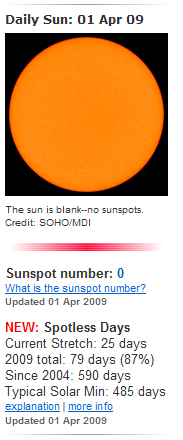 |

|
Spotless Days A spotless day is a day without sunspots, a day when the face of the sun is utterly blank. Spotless days never occur during Solar Max when the sun is active, but they are common during solar minimum, the opposite phase of the 11-year sunspot cycle when the sun is very quiet. By counting spotless days, we can keep track of the depth and longevity of a solar minimum. By the standard of spotless days, the ongoing solar minimum is the deepest in a century: NASA report. In 2008, no sunspots were observed on 266 of the year's 366 days (73%). To find a year with more blank suns, you have to go all the way back to 1913, which had 311 spotless days (85%):
The lack of sunspots in 2008, made it a century-level year in terms of solar quiet. Remarkably, sunspot counts for 2009 have dropped even lower. As of March 31st, there were no sunspots on 78 of the year's 90 days to date (87%).
Current
stretch: 9 days Updated April 4, 2009 2009 Total: 81 days (87%) Updated April 4, 2009 "2009 Total" is the total number of days and the percentage of days in 2009 that the sun has been blank. The 100-year record for a full year is 311 spotless days (85%) in 1913. Since 2004: 592 days Updated April 4, 2009 The first blank sun of the ongoing solar minimum appeared in 2004. "Since 2004" tells us the total number of spotless days since that time. The 100-year record for total spotless days in an entire multi-year minimum is 1019 spotless days in the years around 1913. Typical Solar Min: 485 days Looking back at the last ten solar minima (not including the ongoing minimum), we can count the total number of spotless days in each and calculate an average: 485 spotless days. The average exceeds the number of days in a year because solar minima last much longer than one year. The fact that the ongoing solar minimum has already racked up 590+ spotless days with no end in sight tells us that it is much deeper and longer than average. This page will be updated with more information and data in the days ahead. RELATED LINKS: Sunspot Plotter -- Explore the sunspot cycle with this interactive tool Solar Influences Data Center -- source of the official International Sunspot Number. Rudolf Wolf -- inventor of the modern sunspot number Severe Space Weather--Social and Economic Impacts Spotless Sun--the Blankest Year of the Space Age
©2009 Spaceweather.com.
All rights reserved.
|
|

 On
the front page of spaceweather.com, you can monitor the increasing
number of spotless days. Look beneath the Daily Sun image for these
key indicators (updated daily):
On
the front page of spaceweather.com, you can monitor the increasing
number of spotless days. Look beneath the Daily Sun image for these
key indicators (updated daily):